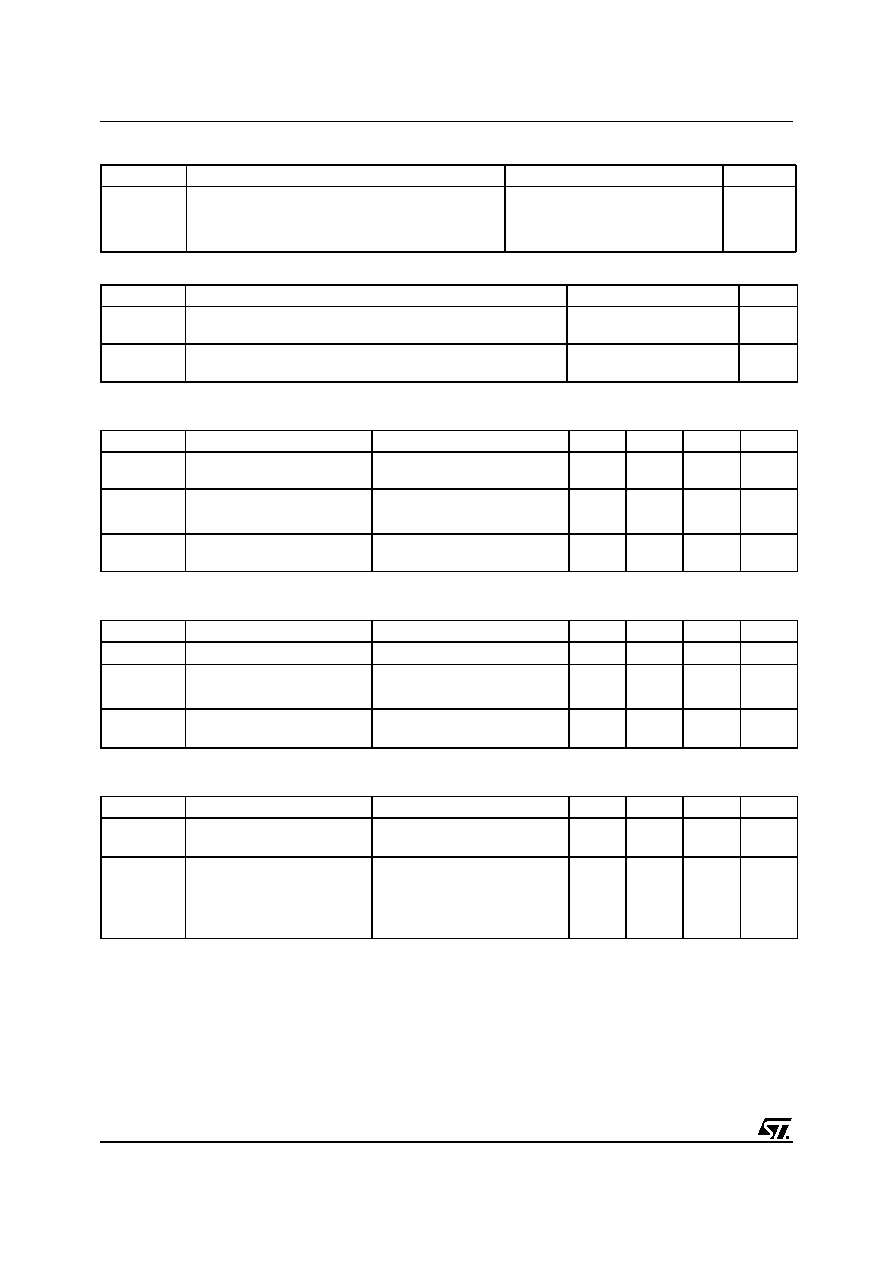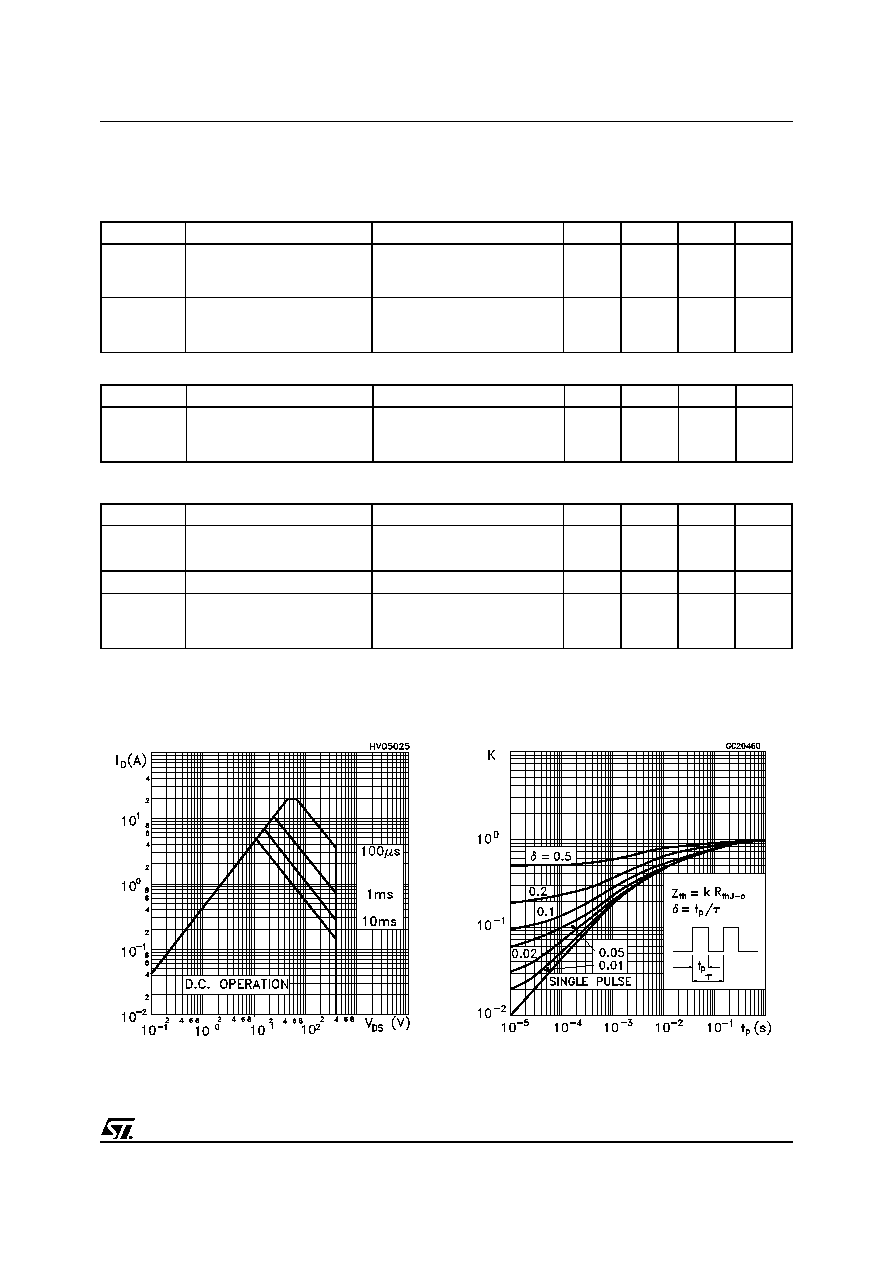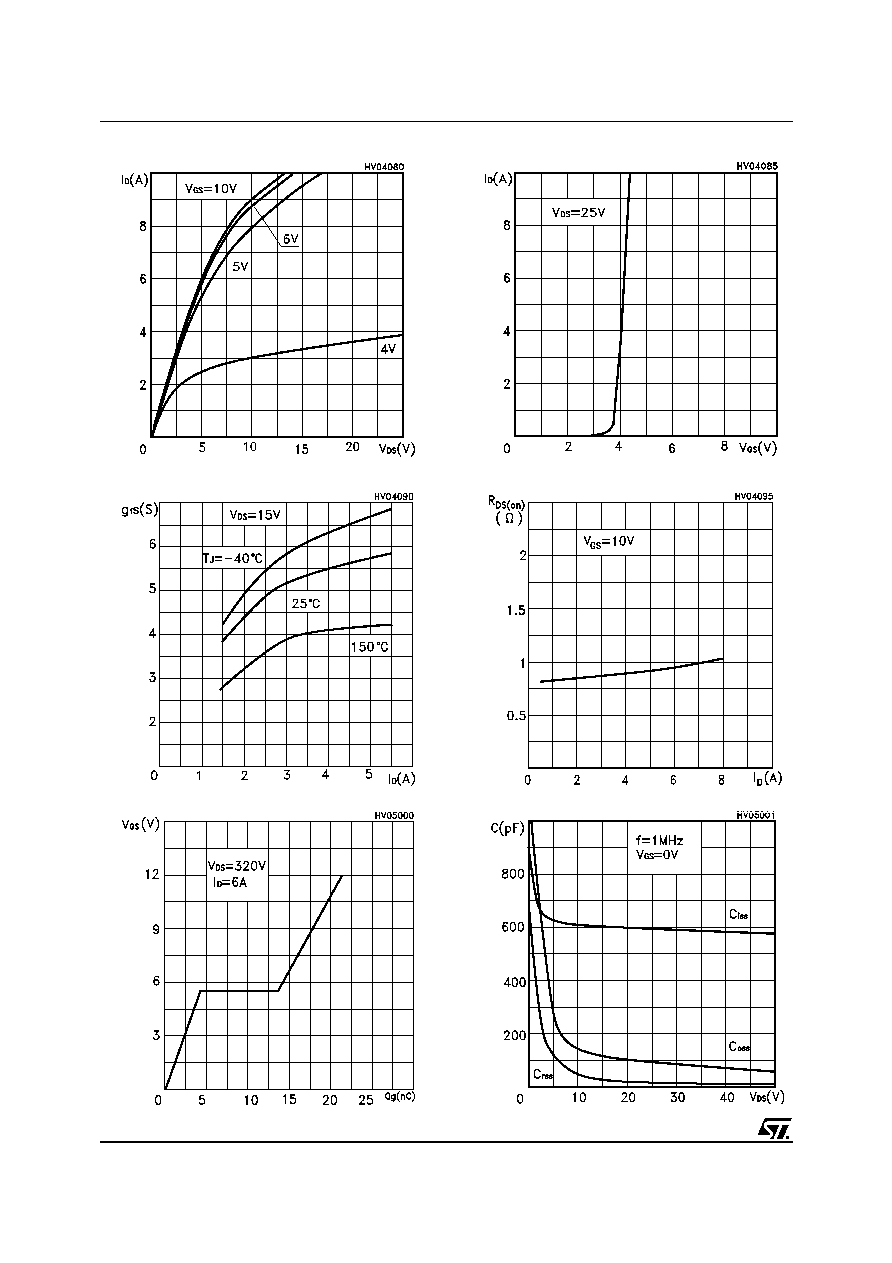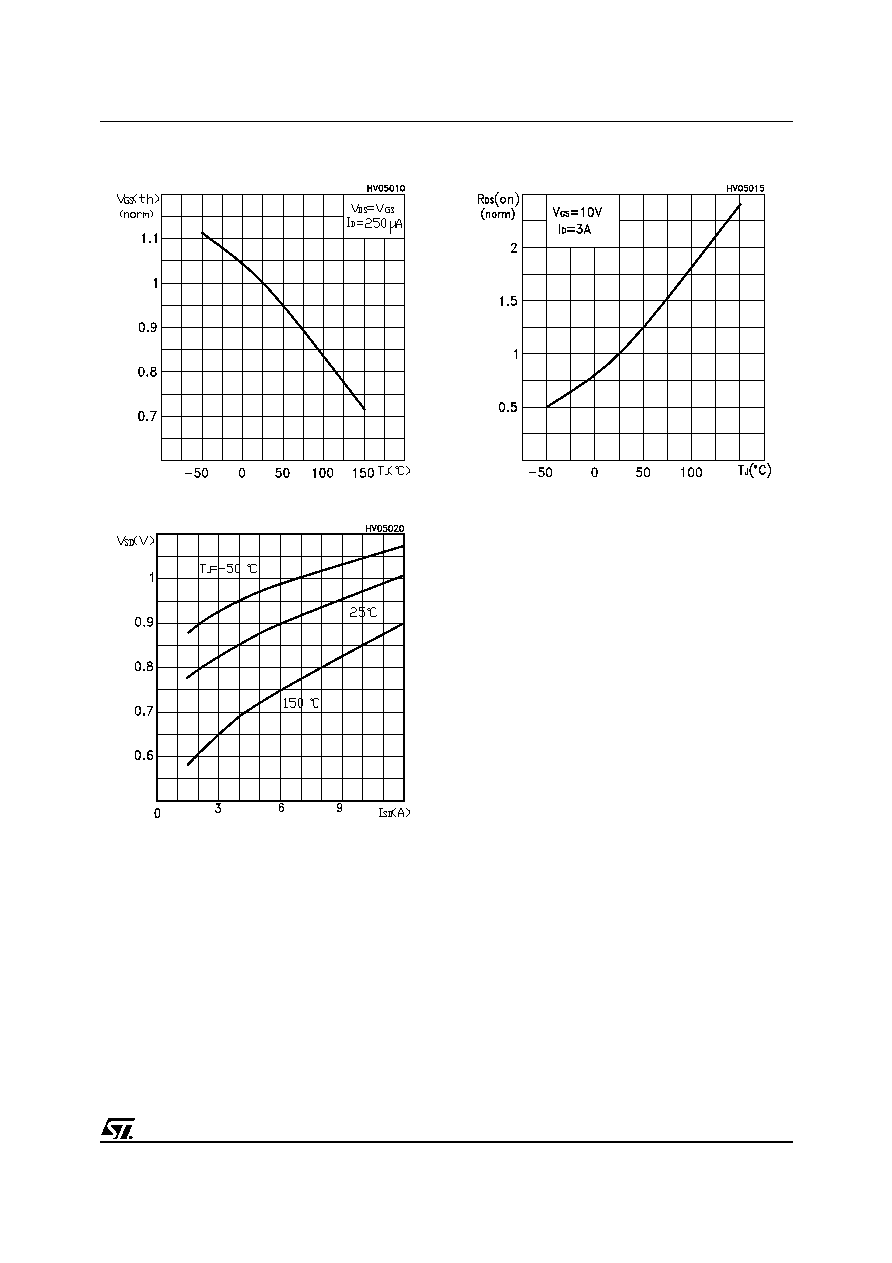
1/9
March 2001
STD6NC40
N-CHANNEL 400V - 0.75
- 5A - DPAK / IPAK
PowerMeshTMII MOSFET
(1)I
SD
5A, di/dt
100A/µs, V
DD
V
(BR)DSS
, T
j
T
JMAX.
s
TYPICAL R
DS
(on) = 0.75
s
EXTREMELY HIGH dv/dt CAPABILITY
s
100% AVALANCHE TESTED
s
GATE CHARGE MINIMIZED
s
ADD SUFFIX "T4" FOR ORDERING IN TAPE &
REEL
s
ADD SUFFIX "-1" FOR ORDERING IN IPAK
DESCRIPTION
The PowerMESH
TM
II is
the evolution of the first
generation of MESH OVERLAY
TM.
The layout re-
finements introduced greatly improve the Ron*area
figure of merit while keeping the device at the lead-
ing edge for what concerns swithing speed, gate
charge and ruggedness.
APPLICATIONS
s
SWITH MODE LOW POWER SUPPLIES
(SMPS)
s
CFL
ABSOLUTE MAXIMUM RATINGS
(∑)Pulse width limited by safe operating area
TYPE
V
DSS
R
DS(on)
I
D
STD6NC40
400V
< 1
5A
Symbol
Parameter
Value
Unit
V
DS
Drain-source Voltage (V
GS
= 0)
400
V
V
DGR
Drain-gate Voltage (R
GS
= 20 k
)
400
V
V
GS
Gate- source Voltage
±30
V
I
D
Drain Current (continuos) at T
C
= 25∞C
5
A
I
D
Drain Current (continuos) at T
C
= 100∞C
3
A
I
DM
(
s
)
Drain Current (pulsed)
20
A
P
TOT
Total Dissipation at T
C
= 25∞C
55
W
Derating Factor
0.44
W/∞C
dv/dt(1)
Peak Diode Recovery voltage slope
3
V/ns
T
stg
Storage Temperature
≠65 to 150
∞C
T
j
Max. Operating Junction Temperature
150
∞C
DPAK
1
3
3
2
1
IPAK
INTERNAL SCHEMATIC DIAGRAM

STD6NC40
2/9
THERMAL DATA
AVALANCHE CHARACTERISTICS
ELECTRICAL CHARACTERISTICS (TCASE = 25 ∞C UNLESS OTHERWISE SPECIFIED)
OFF
ON
(1)
DYNAMIC
Rthj-case
Thermal Resistance Junction-case Max
2.27
∞C/W
Rthj-amb
Thermal Resistance Junction-ambient Max
100
∞C/W
Rthc-sink
Thermal Resistance Case-sink Typ
1.5
∞C/W
T
l
Maximum Lead Temperature For Soldering Purpose
275
∞C
Symbol
Parameter
Max Value
Unit
I
AR
Avalanche Current, Repetitive or Not-Repetitive
(pulse width limited by T
j
max)
6
A
E
AS
Single Pulse Avalanche Energy
(starting T
j
= 25 ∞C, I
D
= I
AR
, V
DD
= 50 V)
320
mJ
Symbol
Parameter
Test Conditions
Min.
Typ.
Max.
Unit
V
(BR)DSS
Drain-source
Breakdown Voltage
I
D
= 250 µA, V
GS
= 0
400
V
I
DSS
Zero Gate Voltage
Drain Current (V
GS
= 0)
V
DS
= Max Rating
1
µA
V
DS
= Max Rating, T
C
= 125 ∞C
50
µA
I
GSS
Gate-body Leakage
Current (V
DS
= 0)
V
GS
= ±30V
±100
nA
Symbol
Parameter
Test Conditions
Min.
Typ.
Max.
Unit
V
GS(th)
Gate Threshold Voltage
V
DS
= V
GS
, I
D
= 250µA
2
3
4
V
R
DS(on)
Static Drain-source On
Resistance
V
GS
= 10V, I
D
= 3 A
0.75
1
I
D(on)
On State Drain Current
V
DS
> I
D(on)
x R
DS(on)max,
V
GS
= 10V
6
A
Symbol
Parameter
Test Conditions
Min.
Typ.
Max.
Unit
g
fs
(1)
Forward Transconductance
V
DS
> I
D(on)
x R
DS(on)max,
I
D
=3A
5.1
S
C
iss
Input Capacitance
V
DS
= 25V, f = 1 MHz, V
GS
= 0
530
pF
C
oss
Output Capacitance
90
pF
C
rss
Reverse Transfer
Capacitance
15
pF

3/9
STD6NC40
ELECTRICAL CHARACTERISTICS (CONTINUED)
SWITCHING ON
SWITCHING OFF
SOURCE DRAIN DIODE
Note: 1. Pulsed: Pulse duration = 300 µs, duty cycle 1.5 %.
2. Pulse width limited by safe operating area.
Symbol
Parameter
Test Conditions
Min.
Typ.
Max.
Unit
t
d(on)
Turn-on Delay Time
V
DD
= 200V, I
D
= 3A,
R
G
= 4.7
V
GS
= 10V
(see test circuit, Figure 3)
11
ns
t
r
Rise Time
15
ns
Q
g
Q
gs
Q
gd
Total Gate Charge
Gate-Source Charge
Gate-Drain Charge
V
DD
= 320V, ID = 6A,
V
GS
= 10V
18
4
8.5
23
nC
nC
nC
Symbol
Parameter
Test Conditions
Min.
Typ.
Max.
Unit
t
r(Voff)
t
f
t
c
Off-voltage Rise Time
Fall Time
Cross-over Time
V
DD
= 320V, I
D
= 6A,
R
G
= 4.7
,
V
GS
= 10V
(see test circuit, Figure 5)
8
12
23
ns
ns
ns
Symbol
Parameter
Test Conditions
Min.
Typ.
Max.
Unit
I
SD
Source-drain Current
6
A
I
SDM
(1)
Source-drain Current (pulsed)
24
A
V
SD
(2)
Forward On Voltage
I
SD
= 6A, V
GS
= 0
1.6
V
t
rr
Q
rr
I
RRM
Reverse Recovery Time
Reverse Recovery Charge
Reverse Recovery Current
I
SD
= 6A, di/dt = 100A/µs,
V
DD
= 100V, T
j
= 150∞C
(see test circuit, Figure 5)
280
1.4
10
ns
µ
C
A
Thermal Impedence
Safe Operating Area

STD6NC40
4/9
Gate Charge vs Gate-source Voltage
Transconductance
Static Drain-source On Resistance
Transfer Characteristics
Output Characteristics
Capacitance Variations

5/9
STD6NC40
Normalized Gate Threshold Voltage vs
Temperature
Source-drain Diode Forward Characteristics
Normalized On Resistance vs Temperature




